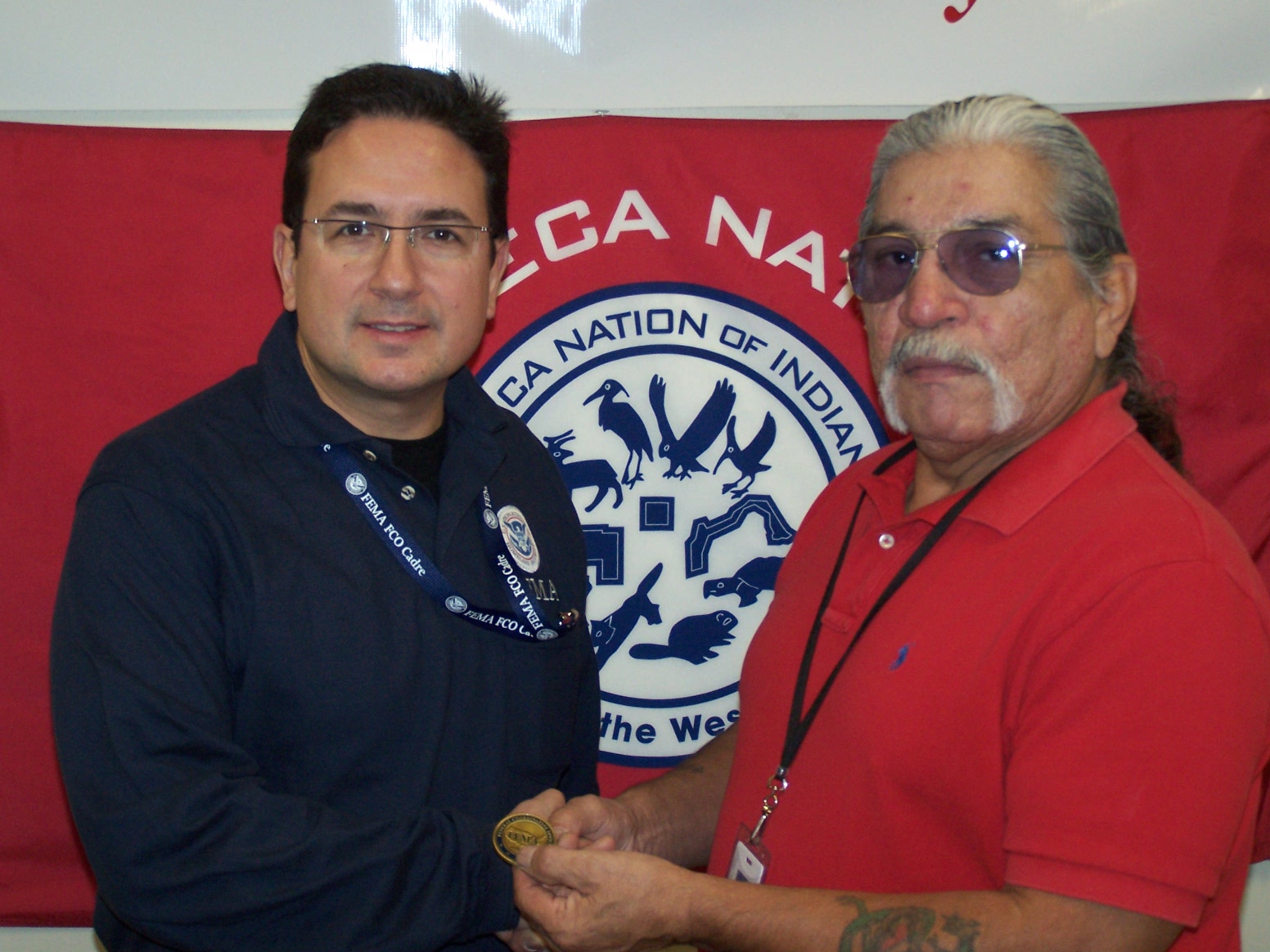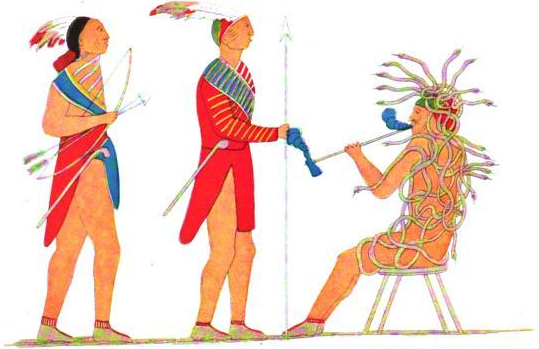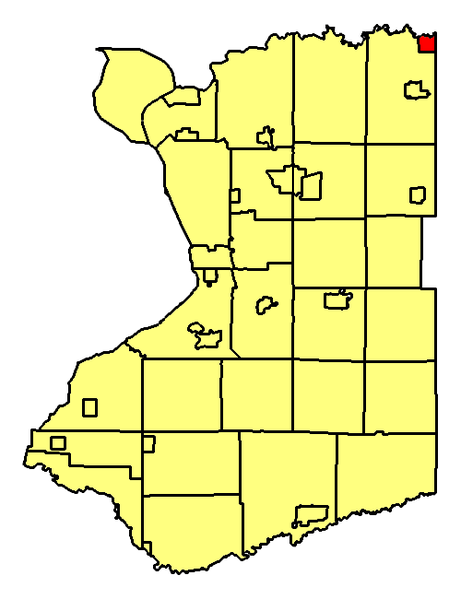|
Senecas
The Seneca () ( see, Onödowáʼga:, "Great Hill People") are a group of Indigenous Iroquoian-speaking people who historically lived south of Lake Ontario, one of the five Great Lakes in North America. Their nation was the farthest to the west within the Six Nations or Iroquois League (Haudenosaunee) in New York before the American Revolution. In the 21st century, more than 10,000 Seneca live in the United States, which has three federally recognized Seneca tribes. Two of them are centered in New York: the Seneca Nation of Indians, with two reservations in western New York near Buffalo; and the Tonawanda Seneca Nation. The Seneca-Cayuga Nation is in Oklahoma, where their ancestors were relocated from Ohio during the Indian Removal. Approximately 1,000 Seneca live in Canada, near Brantford, Ontario, at the Six Nations of the Grand River First Nation. They are descendants of Seneca who resettled there after the American Revolution, as they had been allies of the British and for ... [...More Info...] [...Related Items...] OR: [Wikipedia] [Google] [Baidu] |
Indian Removal
Indian removal was the United States government policy of forced displacement of self-governing tribes of Native Americans from their ancestral homelands in the eastern United States to lands west of the Mississippi Riverspecifically, to a designated Indian Territory (roughly, present-day Oklahoma). The Indian Removal Act, the key law which authorized the removal of Native tribes, was signed by Andrew Jackson in 1830. Although Jackson took a hard line on Indian removal, the law was enforced primarily during the Martin Van Buren administration. After the passage of the Indian Removal Act in 1830, approximately 60,000 members of the Cherokee, Muscogee (Creek), Seminole, Chickasaw, and Choctaw nations (including thousands of their black slaves) were forcibly removed from their ancestral homelands, with thousands dying during the Trail of Tears. Indian removal, a popular policy among incoming settlers, was a consequence of actions by European settlers in North America during th ... [...More Info...] [...Related Items...] OR: [Wikipedia] [Google] [Baidu] |
Seneca Nation Of New York
The Seneca Nation of Indians is a federally recognized Seneca tribe based in western New York. They are one of three federally recognized Seneca entities in the United States, the others being the Tonawanda Band of Seneca (also in western New York) and the Seneca-Cayuga Nation of Oklahoma. Some Seneca also live with other Iroquois peoples on the Six Nations of the Grand River in Ontario. The Seneca Nation has three reservations, two of which are occupied: Cattaraugus Reservation, Allegany Indian Reservation, and the mostly unpopulated Oil Springs Reservation. It has two alternating capitals on the two occupied reservations: Irving at Cattaraugus Reservation, and Jimerson Town near Salamanca on the Allegany Reservation."New York Casinos." ''500 Nations.'' (retrieved 31 May 2010) A fourth territory ''de facto'' governed by th ... [...More Info...] [...Related Items...] OR: [Wikipedia] [Google] [Baidu] |
Seneca Nation Of Indians
The Seneca Nation of Indians is a federally recognized Seneca tribe based in western New York. They are one of three federally recognized Seneca entities in the United States, the others being the Tonawanda Band of Seneca (also in western New York) and the Seneca-Cayuga Nation of Oklahoma. Some Seneca also live with other Iroquois peoples on the Six Nations of the Grand River in Ontario. The Seneca Nation has three reservations, two of which are occupied: Cattaraugus Reservation, Allegany Indian Reservation, and the mostly unpopulated Oil Springs Reservation. It has two alternating capitals on the two occupied reservations: Irving at Cattaraugus Reservation, and Jimerson Town near Salamanca on the Allegany Reservation."New York Casinos." ''500 Nations.'' (retrieved 31 May 2010) A fourth territory ''de facto'' governed by the ... [...More Info...] [...Related Items...] OR: [Wikipedia] [Google] [Baidu] |
Iroquois
The Iroquois ( or ), officially the Haudenosaunee ( meaning "people of the longhouse"), are an Iroquoian-speaking confederacy of First Nations peoples in northeast North America/ Turtle Island. They were known during the colonial years to the French as the Iroquois League, and later as the Iroquois Confederacy. The English called them the Five Nations, comprising the Mohawk, Oneida, Onondaga, Cayuga, and Seneca (listed geographically from east to west). After 1722, the Iroquoian-speaking Tuscarora people from the southeast were accepted into the confederacy, which became known as the Six Nations. The Confederacy came about as a result of the Great Law of Peace, said to have been composed by Deganawidah the Great Peacemaker, Hiawatha, and Jigonsaseh the Mother of Nations. For nearly 200 years, the Six Nations/Haudenosaunee Confederacy were a powerful factor in North American colonial policy, with some scholars arguing for the concept of the Middle Ground, in that Europe ... [...More Info...] [...Related Items...] OR: [Wikipedia] [Google] [Baidu] |
Haudenosaunee
The Iroquois ( or ), officially the Haudenosaunee ( meaning "people of the longhouse"), are an Iroquoian Peoples, Iroquoian-speaking Confederation#Indigenous confederations in North America, confederacy of First Nations in Canada, First Nations peoples in northeast North America/Turtle Island (Native American folklore), Turtle Island. They were known during the Colonial history of the United States, colonial years to the French as the Iroquois League, and later as the Iroquois Confederacy. The English people, English called them the Five Nations, comprising the Mohawk people, Mohawk, Oneida people, Oneida, Onondaga people, Onondaga, Cayuga people, Cayuga, and Seneca people, Seneca (listed geographically from east to west). After 1722, the Iroquoian-speaking Tuscarora people from the southeast were accepted into the confederacy, which became known as the Six Nations. The Confederacy came about as a result of the Great Law of Peace, said to have been composed by The Great Peacem ... [...More Info...] [...Related Items...] OR: [Wikipedia] [Google] [Baidu] |
Buffalo, New York
Buffalo is the second-largest city in the U.S. state of New York (behind only New York City) and the seat of Erie County. It is at the eastern end of Lake Erie, at the head of the Niagara River, and is across the Canadian border from Southern Ontario. With a population of 278,349 according to the 2020 census, Buffalo is the 78th-largest city in the United States. The city and nearby Niagara Falls together make up the two-county Buffalo–Niagara Falls Metropolitan Statistical Area (MSA), which had an estimated population of 1.1 million in 2020, making it the 49th largest MSA in the United States. Buffalo is in Western New York, which is the largest population and economic center between Boston and Cleveland. Before the 17th century, the region was inhabited by nomadic Paleo-Indians who were succeeded by the Neutral, Erie, and Iroquois nations. In the early 17th century, the French began to explore the region. In the 18th century, Iroquois land surrounding Buffalo Creek ... [...More Info...] [...Related Items...] OR: [Wikipedia] [Google] [Baidu] |
Seneca Language
Seneca (; in Seneca, or ) is the language of the Seneca people, one of the Six Nations of the Iroquois League; it is an Iroquoian language, spoken at the time of contact in the western portion of New York. While the name ''Seneca'', attested as early as the seventeenth century, is of obscure origins, the endonym translates to "those of the big hill." About 10,000 Seneca live in the United States and Canada, primarily on reservations in western New York, with others living in Oklahoma and near Brantford, Ontario. As of 2013, an active language revitalization program is underway. Classification and history Seneca is an Iroquoian language spoken by the Seneca people, one of the members of the Iroquois Five (later, Six) Nations confederacy. It is most closely related to the other Five Nations Iroquoian languages, Cayuga, Onondaga, Oneida, and Mohawk (and among those, it is most closely related to Cayuga). Seneca is first attested in two damaged dictionaries produced by the Frenc ... [...More Info...] [...Related Items...] OR: [Wikipedia] [Google] [Baidu] |
Seneca The Elder
Lucius Annaeus Seneca the Elder (; c. 54 BC – c. 39 AD), also known as Seneca the Rhetorician, was a Roman writer, born of a wealthy equestrian family of Corduba, Hispania. He wrote a collection of reminiscences about the Roman schools of rhetoric, six books of which are extant in a more or less complete state and five others in epitome only. His principal work, a history of Roman affairs from the beginning of the Civil Wars until the last years of his life, is almost entirely lost to posterity. Seneca lived through the reigns of three significant emperors; Augustus (ruled 27 BC – 14 AD), Tiberius (ruled 14–37 AD) and Caligula (ruled 37–41 AD). He was the father of Lucius Junius Gallio Annaeanus, best known as a Proconsul of Achaia; his second son was the dramatist and Stoic philosopher Seneca the Younger (''Lucius''), who was tutor of Nero, and his third son, Marcus Annaeus Mela, became the father of the poet Lucan. Biography Seneca the Elder is the first of the gens A ... [...More Info...] [...Related Items...] OR: [Wikipedia] [Google] [Baidu] |
Tonawanda Reservation
The Tonawanda Indian Reservation ( see, Ta:nöwöde') is an Indian reservation of the Tonawanda Seneca Nation located in western New York, United States. The band is a federally recognized tribe and, in the 2010 census, had 693 people living on the reservation. The reservation lies mostly in Genesee County, extending into Erie and Niagara counties. It is bordered by the Towns of Alabama, Pembroke, Newstead, and Royalton. The Tonawanda Reservation is also known as the Tonawanda Creek Reservation. Currently, it has more than a half dozen businesses located on Bloomingdale Road within the reservation. Several sell untaxed, low-price cigarettes and gasoline. Other businesses sell Seneca craft goods, groceries, and prepared food. History After various cultures of indigenous peoples succeeded each other in the Great Lakes area, in late prehistoric times, the five nations of the Iroquois coalesced. Before the mid-14th century, they had formed the Iroquois Confederacy. The Sene ... [...More Info...] [...Related Items...] OR: [Wikipedia] [Google] [Baidu] |
Oneida Nation
The Oneida Nation is a federally recognized tribe of Oneida people in Wisconsin. The tribe's reservation spans parts of two counties west of the Green Bay metropolitan area. The reservation was established by treaty in 1838, and was allotted to individual New York Oneida tribal members as part of an agreement with the U.S. government. The land was individually owned until the tribe was formed under the Indian Reorganization Act of 1934. Under the Dawes Act, the land was allotted in 1892 to individual households. The nation kept control of most of the land until sales were allowed in the early 20th century, when members were often tricked out of their property. They used the land for farming and harvesting timber. As of 2010, the nation controlled about 35 percent of the land within its reservation and is working to reacquire the rest. In 1988 the nation established the state's first modern lottery, known as Big Green. Since the late 20th century, the nation developed the gaming ... [...More Info...] [...Related Items...] OR: [Wikipedia] [Google] [Baidu] |
English Language
English is a West Germanic language of the Indo-European language family, with its earliest forms spoken by the inhabitants of early medieval England. It is named after the Angles, one of the ancient Germanic peoples that migrated to the island of Great Britain. Existing on a dialect continuum with Scots, and then closest related to the Low Saxon and Frisian languages, English is genealogically West Germanic. However, its vocabulary is also distinctively influenced by dialects of France (about 29% of Modern English words) and Latin (also about 29%), plus some grammar and a small amount of core vocabulary influenced by Old Norse (a North Germanic language). Speakers of English are called Anglophones. The earliest forms of English, collectively known as Old English, evolved from a group of West Germanic (Ingvaeonic) dialects brought to Great Britain by Anglo-Saxon settlers in the 5th century and further mutated by Norse-speaking Viking settlers starting in the 8th and 9th ... [...More Info...] [...Related Items...] OR: [Wikipedia] [Google] [Baidu] |
Six Nations Land Cessions
The Six Nations land cessions were a series of land cessions by the Haudenosaunee and Lenape which ceded large amounts of land, including both recently conquered territories acquired from other indigenous peoples in the Beaver Wars and ancestral lands to the Thirteen Colonies and the United States. The land ceded covered, partially or in the entire, the U.S. states of New York, Pennsylvania, Maryland, Virginia, West Virginia, Kentucky, Ohio, Tennessee and North Carolina. They were bordered to the west by the Algonquian lands in the Ohio Country, Cherokee lands to the south, and Muscogee and Choctaw lands to the southeast. The land cessions were accomplished through a series of purchases and treaties negotiated between the Haudenosaunee and the Province of New York (and after the American Revolution, the United States government) between 1682 and 1797. In the Nanfan Treaty of 1701, the Haudenosaunee had ceded their lands north and west of the Ohio River to the Thirteen Colonies, ... [...More Info...] [...Related Items...] OR: [Wikipedia] [Google] [Baidu] |





